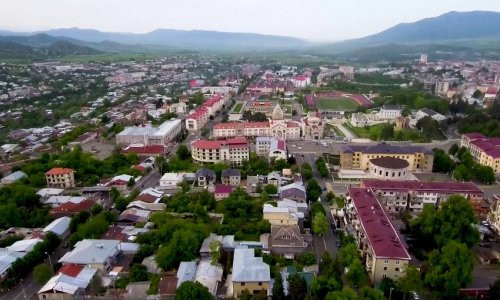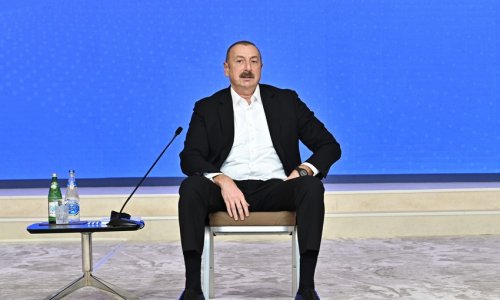Lenders of last resort are becoming agents of change for economies across the former Soviet Union.
Their governments paralyzed by collapsing revenue, central banks sprang into action when the crisis hit last year, allowing more flexible currencies to take root from Belarus to Azerbaijan.
Policy makers in Ukraine slimmed down the bloated bureaucracy and used competitive salaries to lure top executives from local banks, while their counterparts in Russia shut down the most lenders in more than a decade as part of a campaign to clamp down on dubious transactions and improve lending practices.
"These central banks are leading policy reform and economic innovation,” said Oleg Kouzmin, a former central bank adviser in Russia who’s now an economist at Renaissance Capital in Moscow. "In CIS countries, the central banks are the most efficient institutions when it comes to policy making, communication, development.”
Usually the last line of defense during financial meltdowns, central banks in an area from the Caspian to the Pacific have tried to do more than make sure their economies live to fight another day, breathing new life into the reform agenda stalled by crises. The devaluations in the region, while stoking inflation and devastating incomes, may also pave the way for a faster economic rebound. The International Monetary Fund predicts that gross domestic product will expand next year in the Commonwealth of Independent States, a loose grouping of former Soviet countries, growing 0.5 percent after a 2.7 percent contraction in 2015.
Corruption, Oil
Changes in currency management and bank oversight still fall short of an overhaul needed for economies that remain riddled with corruption and vulnerable to swings in commodity prices. Bank of Russia Governor Elvira Nabiullina said in an October interview that the pace of structural reforms worried her more than a prolonged drop in oil prices. "Neither monetary nor budget policy can create stable economic growth,” she said.
World’s Worst
The performance of currencies in former Soviet republics shows the scale of their adjustment to a regional crisis that began with the standoff over Ukraine in early 2014 and intensified after sanctions against Russia and the largest commodity collapse in a generation.
Azerbaijan’s manat and Kazakhstan’s tenge are the world’s worst performers against the dollar this year and Ukraine’s hryvnia and the Russian ruble were the biggest losers globally in 2014.
Russia’s central bank moved to a free float ahead of schedule in November 2014 to safeguard reserves. While the shift to inflation targeting has been on the regulator’s agenda for a decade, the crisis lent new urgency to the plans. Kazakhstan, Azerbaijan and Belarus soon loosened control over their currencies as well.
Under the stewardship of Pavel Kallaur, the Belarusian central bank is moving ahead with the country’s biggest currency re-denomination and keeping policy tight. It’s also unveiled a plan to allow all citizens access to financial services at any bank next year via a universal login to increase competition among lenders.
‘Prolonged Crisis’
"If the central bank continued with the same policy as before, the country would be back into a prolonged crisis,” said Alexander Chubrik, director at the IPM Research Center in the capital, Minsk, and a member of the central bank’s advisory board.
Among the former Soviet central bankers who’ve seized the mantle of reform, none have been put to a bigger test than Valeriya Gontareva, who took over the National Bank of Ukraine at the height of the separatist insurgency raging in the country’s east in the summer of 2014. Speaking to reporters in Kiev on Tuesday, she described the situation the central bank faced early this year as a "perfect storm.”
Lacking central banking experience after almost two decades in finance, Gontareva was handed an economy on the brink of bankruptcy. Gontareva revamped the central bank’s operations and moved to contain a financial crisis with a program of stress tests and restructuring for lenders. The regulator has also made price growth, the world’s second-fastest, its focus after embarking on a transition to inflation targeting.
Risk, Responsibility
"A political, military and economic crisis isn’t a reason not to conduct reforms,” Gontareva said. "We took a risk, took responsibility.”
The central bank’s reorganization, including its reduction of personnel by more than half, is projected to save 7.3 billion hryvnia ($303 million) in 2014-2016, according to Gontareva. Annual savings on operational expenditures are estimated at more than 1 billion hryvnia from 2017, she said.
"The reforms instigated at the National Bank of Ukraine have been revolutionary,” said Timothy Ash, a credit strategist at Nomura International Plc. in London. "If it can do all this, against entrenched vested interests, then such reforms can be rolled out and succeed elsewhere in Ukraine.”
While designed to combat the fallout of the crisis engulfing the former Soviet Union, the changes will probably long outlive the current downturn.
Under Pressure
Even so, central bankers will still have to contend with authoritarian rulers who often have the final say in all matters of economic policy. There’s a 50 percent chance Kazakhstan will abandon its free float in the next 12 months, according to a November survey of economists by Bloomberg.
"The central banks should be independent to a bigger extent than now, while in all these countries they help the government to achieve some macro goals and act under pressure,” said Dmitry Polevoy, chief economist for Russia and the CIS at ING in Moscow. "This needs to be changed.”
(Bloomberg)
(Bloomberg)
www.ann.az
Follow us !











